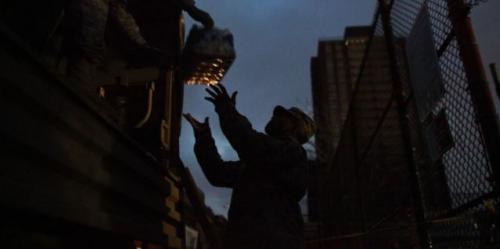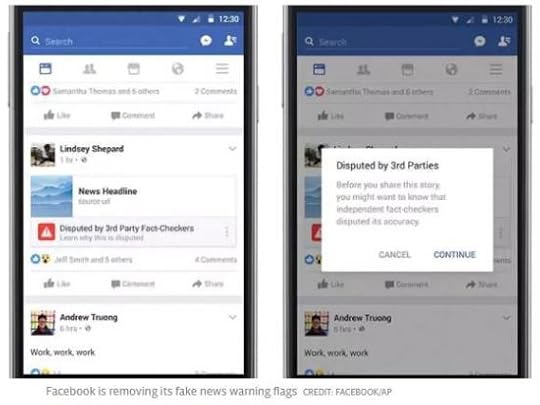Steve Bull's Blog, page 1223
December 23, 2017
Edward Snowden’s New App Uses Your Smartphone to Physically Guard Your Laptop

Illustration: The Intercept
EDWARD SNOWDEN’S NEW APP USES YOUR SMARTPHONE TO PHYSICALLY GUARD YOUR LAPTOP
LIKE MANY OTHER journalists, activists, and software developers I know, I carry my laptop everywhere while I’m traveling. It contains sensitive information; messaging app conversations, email, password databases, encryption keys, unreleased work, web browsers logged into various accounts, and so on. My disk is encrypted, but all it takes to bypass this protection is for an attacker — a malicious hotel housekeeper, or “evil maid,” for example — to spend a few minutes physically tampering with it without my knowledge. If I come back and continue to use my compromised computer, the attacker could gain access to everything.
Edward Snowden and his friends have a solution. The NSA whistleblower and a team of collaborators have been working on a new open source Android app called Haven that you install on a spare smartphone, turning the device into a sort of sentry to watch over your laptop. Haven uses the smartphone’s many sensors — microphone, motion detector, light detector, and cameras — to monitor the room for changes, and it logs everything it notices. The first public beta version of Haven has officially been released; it’s available in the Play Store and on F-Droid, an open source app store for Android.
Snowden is helping to develop the software through a project he leads at the Freedom of the Press Foundation, which receives funding from The Intercept’s parent company. I sit on the FPF board with Snowden, am an FPF founder, and lent some help developing the app, including through nine months of testing. With that noted, I’ll be forthright about the product’s flaws below, and have solicited input for this article from people not involved in the project.
Also collaborating on Haven is the Guardian Project, a global collective of mobile security app developers.
…click on the above link to read the rest of the article…
H.G. Wells and Orwell on Whether Science Can Save Humanity
Though Wells and Orwell were debating in the era of Nazism, many of their arguments reverberate today.
In the midst of contemporary science’s stunning discoveries and innovations – for example, 2017 alone brought the editing of a human embryo’s genes, the location of an eighth continent under the ocean and the ability to reuse a spacecraft’s rocket boosters – it’s easy to forget that there’s an ongoing debate over science’s capacity to save humankind. Seventy-five years ago, two of the best-known literary figures of the 20th century, H.G. Wells and George Orwell, carried on a lively exchange over this very issue.
Wells, one of the founders of science fiction, was a staunch believer in science’s potential. Orwell, on the other hand, cast a much more skeptical eye on science, pointing to its limitations as a guide to human affairs.
Expecting from science what it cannot deliver is just as hazardous as failing to acknowledge its great potential.
Though Wells and Orwell were debating in the era of Nazism, many of their arguments reverberate today in contemporary debates over science and policy. For example, in 2013, biologist Richard Dawkins justified confidence in science in these terms: “Science works. Planes fly. Cars drive. Computers compute. If you base medicine on science, you cure people. If you base the design of planes on science, they fly. It works….”On the other hand, Nobel laureate Peter Medawar famously argued that there are many important questions that science cannot answer, such as, “What is the purpose of life?” and “To what uses should scientific knowledge be put?”
Confronting challenges such as climate change and feeding the 2 billion people who lack a reliable source of food, it might be natural to regard science as humanity’s only hope. But expecting from science what it cannot deliver is just as hazardous as failing to acknowledge its great potential.
2017: Carbon Brief’s end-of-year review
As the year draws to a close, Carbon Brief takes a look at 2017’s top climate and energy stories through the medium of numbers…
49 countries
For CO2 emissions to fall, they first have to peak. And research published this year suggests that this is already happening.
The report, produced by the US-based World Resources Institute (WRI), suggests that 49 countries – which include the UK, US, Australia, Brazil and Canada – have seen their emissions peak, representing around 36% of current global emissions.
Carbon Brief created an interactive chart of WRI’s data as part of our coverage.
But how much time does the world collectively have left to reduce its emissions in order to avoid dangerous climate change?
At the beginning of the year, Carbon Brief published our traditional carbon budget update, revealing that just four years of current CO2 emissions would blow what’s left of the budget for a good chance of keeping global temperature rise to 1.5C.
However, in September, a new study published in Nature Geoscience proposed that there might be a little more breathing space to meet the 1.5C limit than previously thought.
As lead author Dr Richard Millar explained in a guest post, the study estimates the remaining 1.5C carbon budget from today onwards. This contrasts to previous methods which have been based on cumulative emissions to date. As a result, Millar’s study put the remaining 1.5C budget at around 20 years of current emissions.
The paper caused quite a stir, with parts of the media claiming that climate models – the basis for carbon budget estimates – are “wrong” and have overstated the observed warming of the planet.
Carbon Brief factchecked these claims, showing that the model-observation comparisons in the study depend greatly on the dataset and model outputs used by the authors.
…click on the above link to read the rest of the article…
Can The US Survive An EMP Attack?
While there’s no question that a nuclear strike on the Continental US would be utterly devastating, it’s not the only way a rogue state like North Korea could kill millions of American civilians in one fell swoop.
Another possibility that is being studied by lawmakers and Pentagon officials is – like North Korea itself – a vestige of the Cold War. We’re of course referring to an electromagnetic pulse. By detonating a hydrogen bomb in just the right spot miles above the Earth’s surface, the North could permanently damage the US power grid – maybe even take it offline completely. By robbing entire swaths of the US of electricity, the North could precipitate thousands – if not millions – of deaths.
The North first threatened an EMP attack over the summer, and North Korean media and its people have mentioned it several times since.
Given the success of the North’s missile tests, Congress increased funding for the Commission to Assess the Threat to the US from Electromagnetic Pulse Attack as part of the National Defense Authorization Act back in September.
Last month, federal agencies and utility executives held GridEx IV, a biennial event where officials responsible for hundreds of local utilities game out scenarios in which North America’s power grid could fail. Unsurprisingly, with the North Korean threat looming, these discussions took on a whole new level of urgency, as Bloomberg explains.
This year, the event took on an added urgency given growing concern with a weapon straight out of the Cold War: an electromagnetic pulse, or EMP, emanating from a nuclear blast – specifically, one delivered by a North Korean missile or satellite detonated miles above the Earth. Though GridEx IV didn’t pose this exact scenario, industry experts concede there’s no clear plan to deal with it.
…click on the above link to read the rest of the article…
A Dam(n) Big Fracking Problem
Regulators left behind as industry built dozens of unauthorized dams — many at risk of failure.
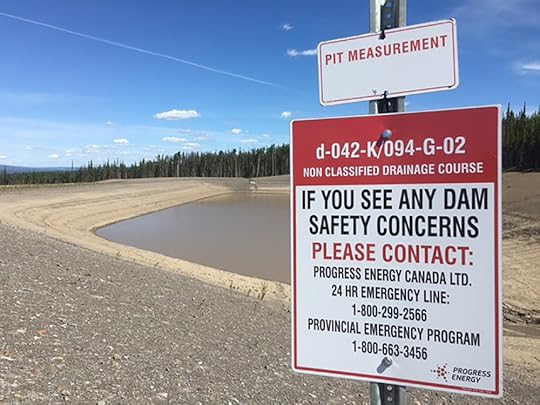 The province’s Environmental Assessment Office has ordered Progress Energy to drain almost all water from this seven-storey dam, built without required approvals. The company is now seeking a retroactive exemption from the assessment process. Photo by Ben Parfitt.
The province’s Environmental Assessment Office has ordered Progress Energy to drain almost all water from this seven-storey dam, built without required approvals. The company is now seeking a retroactive exemption from the assessment process. Photo by Ben Parfitt.More than half of 48 dams that oil and gas companies built in recent years without first obtaining the proper permits had serious structural problems that could have caused many to fail.
And now, the BC Oil and Gas Commission, which appeared to be asleep at the switch in allowing the unlicensed dams to be built in the first place, is frantically trying to figure out what to do about them after the fact.
Information about the unprecedented, unregulated dam-building spree is contained in a raft of documents that the commission released in response to freedom of information requests filed by the Canadian Centre for Policy Alternatives.
The documents obtained by the CCPA, along with other materials recently posted on the OGC’s website, reveal that 28 of at least 48 unlicensed dams on Crown (meaning public) lands had significant structural flaws or other problems belatedly identified by commission staff.
All the dams were built to trap fresh water used by energy companies drilling and fracking for gas in northeast B.C. In some fracking operations in the region, companies are pressure-pumping the equivalent of 64 Olympic-size swimming pools of water underground to break open gas-bearing rock formations, triggering earthquakes in the process.
The OGC paved the way for the construction of the dams by granting companies numerous permits under the Land Act to use public lands to “store water.”
But in approving the applications, commission personnel failed to ask basic, critical questions: How did companies intend to store the water? In tanks? In pits? Behind dams?
…click on the above link to read the rest of the article…
December 22, 2017
Canadian Housing Affordability Hits 27 Year Low
Real Estate Hasn’t Been this Unaffordable Since 1990 per RBC
Nothing says Merry Christmas like a 27 year low for Canadian housing affordability. That’s right, real estate across Canada has not been this un affordable since the year 1990 per RBC. Spoiler alert house prices tumbled shortly thereafter.
RBC Bank released their updated Q3 numbers for housing affordability. To no surprise, Vancouver leads the nation in the most unaffordable market to buy a home. Followed by Toronto and then Victoria.
“The deterioration in the latest two quarters, in fact, put Vancouver buyers in the worst affordability position ever recorded in Canada.”
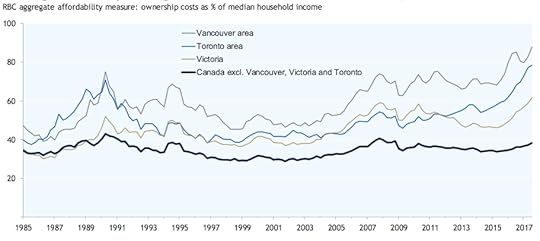 Source: RBC
Source: RBCVancouver Un affordability Sets New High In Canada
“The area experienced the sharpest affordability drop among Canada’s major markets between the second and third quarters. RBC’s aggregate measure surged by 5.3 percentage points to 87.5%. This represents a new record high for any market in Canada. We see further downside to Vancouver’s home ownership rate in the period ahead. The rate fell from 65.5% in 2011 to 63.7% in 2016.”
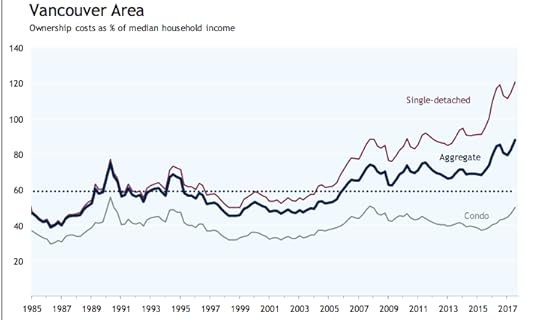 Source: RBC – Vancouver housing affordability Q3 2017
Source: RBC – Vancouver housing affordability Q3 2017High Un affordability Tends to Lead to Recessions
What RBC didn’t mention in their report is the correlation between elevated house prices that cause affordability issues and recessions. When too much household money is spent servicing mortgage payments it eventually becomes a drag on consumer spending and ultimately triggers a recession.
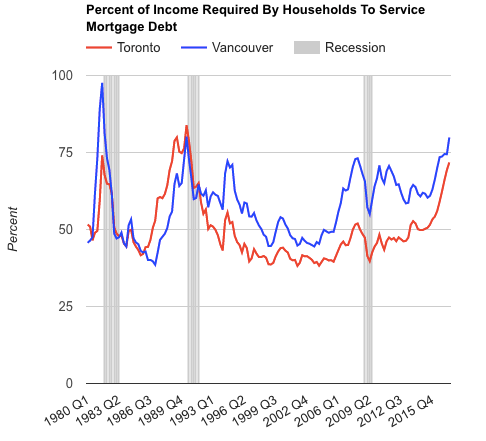 Source: Better Dwelling
Source: Better DwellingThis is not to suggest a recession is imminent. But when the percent of income the median family would have to use to service debt pushes above 50% in Toronto and Vancouver, a recession typically follows in Canada. Currently Toronto is at 71.7%, and Vancouver is at 79.87%.
…click on the above link to read the rest of the article…
Facebook Ditches Its “Fake News Flag” After People Shared Flagged Articles Even More
Roughly one year ago Facebook promised to eradicate “fake news” from its platform by “flagging” articles that were deemed inaccurate by their hand-selected “fact checkers” (A.K.A. “liberal propagandists”)…we wrote all about it in a post entitled “Facebook Launches Campaign To Combat ‘Fake News’“.
Among other things, the crusade attempted to dissuade people from sharing certain content, like the $100,000 of Russia ads that apparently changed the course of human history, by shaming them with a big red caution flag underneath their post. Per The Telegraph, it looked something like this:
Unfortunately, after a year of trials, it seems that Facebook users were not shamed by Zuckerberg’s ‘scarlet letter’ but actually wore it as a badge of honor and shared those articles even more than they otherwise would have…oops.
Facebook is getting rid of its fake news red flags because they were making fabricated media reports appear more believable to its users.
The U-turn was prompted by research suggesting users would actually believe fake news even if it was flagged as incorrect or a misleading.
“Academic research on correcting misinformation has shown that putting a strong image, like a red flag, next to an article may actually entrench deeply held beliefs – the opposite effect to what we intended,” Facebook product manager Tessa Lyons wrote in a blog-post.
As a result, Facebook is ditching the “fake news flag” and instead force feeding users articles that more closely align with Zuckerberg’s political beliefs before allowing them to share articles that have been deemed ‘inconvenient’ for one reason or another.
…click on the above link to read the rest of the article…
2017 Year in Review–James Howard Kunstler
2017 was the kind of year when no amount of showers could wash off the feeling of existential yeccchhhhh that crept over you day after day like jungle rot. You needed to go through the carwash without your car… or maybe an acid bath would get the stink off. Cinematically, if 2016 was like The Eggplant That Ate Chicago, then 2017 was more like Alfred Hitchcock’s Psycho, a gruesome glimpse into the twisted soul of America. And by that I do not mean simply our dear leader, the Golden Golem of Greatness. We’re all in this horror show together.
2017 kicked off with the report by “seventeen intelligence agencies” — did you know there were so many professional snoops and busybodies on the US payroll? — declaring that Russia, and Vladimir Putin personally, tried to influence the 2016 presidential election. “Meddling” and “collusion” became the watch-words of the year: but what exactly did they mean? Buying $100,000 worth of Google ads in a campaign that the two parties spent billions on? No doubt the “seventeen intelligence agencies” the US pays for were not alert to these shenanigans until the damage was done. Since then it’s been Russia-Russia-Russia 24/7 on the news wires. A few pleas bargains have been made to lever-up the action. When and if the Special Prosecutor, Mr. Mueller, pounces, I expect the GGG to fire him, pardon some of the plea-bargained culprits (if that’s what they were and not just patsies), and incite a constitutional crisis. Won’t that be fun?
Anyway, that set the tone for the inauguration of the Golden Golem, a ghastly adversarial spectacle. Never in my memory, going back to JFK in 1960, was there such a bad vibe at this solemn transfer of power as with the sight of all those Deep State dignitaries gathering gloomily on the Capitol portico to witness the unthinkable.
…click on the above link to read the rest of the article…
Putin Warns “Russia Has Right To Respond” To US Military Buildup, Hints At Use Of Nuclear Weap
Multiple Russian state media outlets are reporting that President Vladimir Putin has stressed that Russia has a right to respond to US military build-up in Europe while furthering its strategic nuclear deterrence capabilities in a speech delivered before a Defense Ministry meeting on Friday in the city of Balashikha outside of Moscow.
At the same meeting Russian Defense Minister Sergei Shoigu said that NATO has doubled the number of its military drills since 2012 in the vicinity of Russia’s borders, noting that Russia is carefully monitoring what it considers hostile NATO build-up and intensified surveillance operations along Russian borders. The defense minister further indicated that the number of NATO-member country troops stationed near Russian borders has tripled, growing from 10 to 40 thousand in three years, saying “In the Baltic states and Poland, four battalion-tactical groups, an armored brigade of the US Army, headquarters of NATO multinational divisions in Poland and Romania are deployed.”
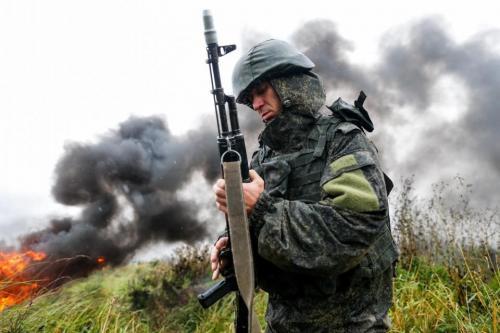
Russian solider during the September “Zapad” (West) war games. Image source: Getty
Since the crisis in Ukraine (which began in 2014) and Russia’s subsequent annexation of the Crimea, an Obama administration policy of steady build-up and periodic war games has been in place in East European and the Baltic countries, including Bulgaria, Poland, Estonia, Latvia, Lithuania and Romania. A little under a year ago a Reuters report acknowledged that NATO has been “expanding its presence in the region to levels unprecedented since the Cold War” – something which the Pentagon has long touted as defensive in nature.
And just this week news broke that after months of indecision over whether or not to move forward with Obama-era legislation which initially paved the way for legalizing US arms sales to Ukraine, Trump has approved the first ever US commercial sale of weapons to the Kiev government, which Moscow sees as an illegitimate puppet regime supported by the West.
…click on the above link to read the rest of the article…
Gold EFPs: Absolute Proof That Paper Gold Is A Fraud
IRD’s Note: In the past year, there has been a noticeably substantial increase in the use of the obscurely defined EFPs (Exchange for Physicals) and PNTs (Privately Negotiated Transactions) in the settlement of Comex gold and silver futures contracts. In simple terms, the EFPs and PNTs enable the counterparties a Comex futures contract or LBMA forward to settle the contract in an acceptable form other than the actual physical commodity as required by the contract specifications (e.g. one gold futures contract requires the delivery of a 100 oz. gold bar as qualified by the Comex). As an example, the counterparty that is required to deliver gold under Comex contract terms can deliver a comparable dollar amount of GLD shares if the counterparty standing for delivery agrees to take delivery of the GLD shares.
The EFPs and PNTs plunge the Comex operations into even greater opacity – likely intentionally. In all probability, the EFPs and PNTs are used to bridge the gap between the amount of gold (silver) that needs to be delivered and the amount of gold (silver) that is available to be delivered. The settlement of the contract occurs outside of the Comex. These contract settlement devices further enable the ability of the western Central Banks to execute the successful manipulation of the gold (silver) price.
*************************
In recent months, the issuance of gold Exchange for Physical (EFP) contracts has surged. EFPs convert a physically deliverable Comex gold contract into an LBMA or LME contract supposedly deliverable at a later date ex London and/or Hong Kong. As an incentive for Comex contract holders to accept EFPs, a cash bonus reportedly is paid. EFPs in silver are also being issued in vast quantities, but we will focus on gold for brevity.
…click on the above link to read the rest of the article…

